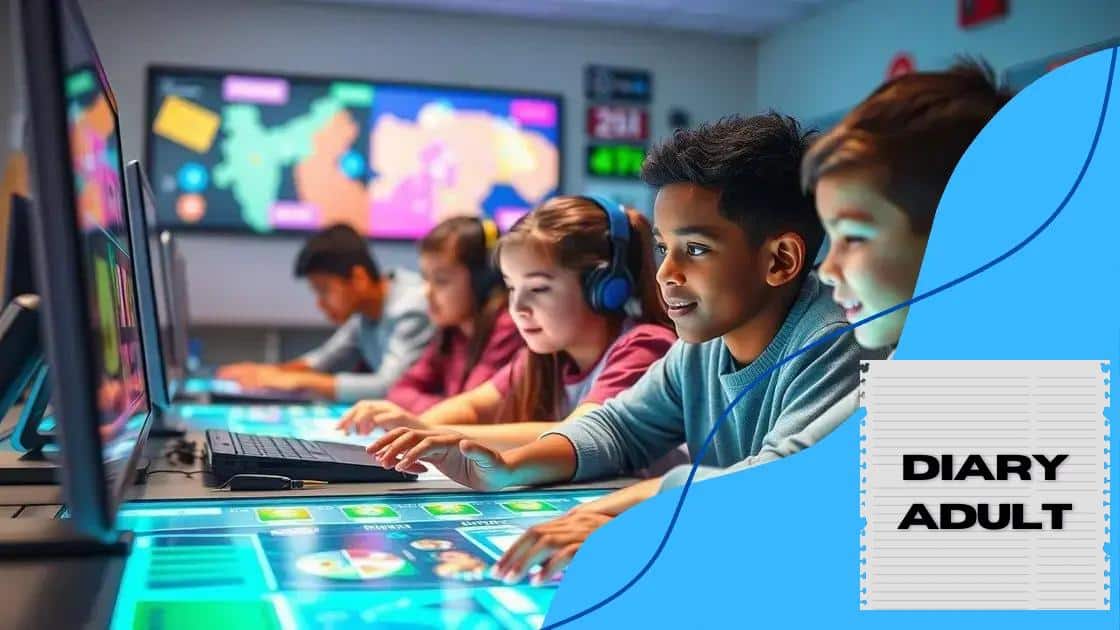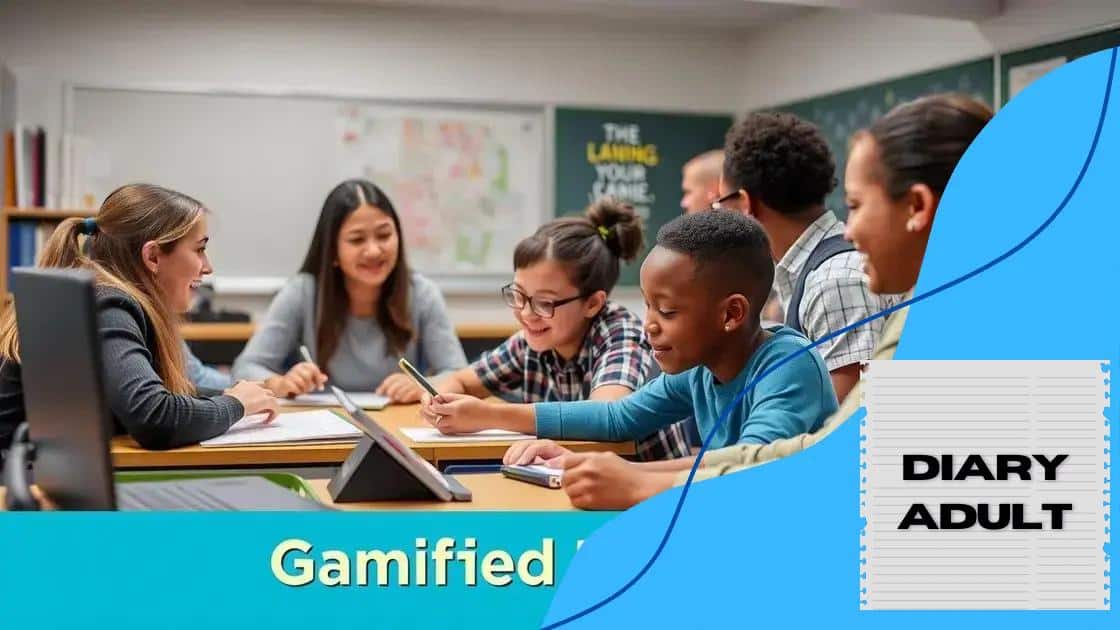Gamified learning tools to improve student engagement

Gamified learning tools enhance student engagement and motivation by incorporating game mechanics, such as rewards and challenges, transforming traditional education into dynamic and interactive experiences.
Gamified learning tools are transforming the educational landscape, making learning more engaging and interactive. Have you ever wondered how these tools can captivate students and enhance their motivation? Let’s dive into this exciting world!
Understanding gamified learning tools
Understanding gamified learning tools is essential for educators looking to enhance student engagement. These tools integrate game-like elements into educational settings, allowing for a more interactive learning experience. By exploring how these tools work, we can see their potential in transforming traditional learning environments.
What are gamified learning tools?
Gamified learning tools are designed to motivate students by making learning fun. They often include features such as points, badges, levels, and rewards, which can encourage students to participate actively. These elements not only make learning enjoyable but also foster a sense of achievement.
Key features of gamified learning tools
- Interactive challenges: Tools often present challenges that students must complete to progress, keeping them engaged.
- Instant feedback: Students receive immediate feedback on their performance, allowing them to learn from mistakes and celebrate successes.
- Collaboration: Many tools encourage teamwork, helping students to develop communication and social skills.
Understanding these features helps educators choose the right tools for their classrooms. By leveraging technology, we can create a more motivating environment for learners. Effective gamified learning tools can lead to higher retention rates and deeper understanding of content.
For instance, platforms like Kahoot! and Quizlet engage students through quizzes and interactive games. These tools not only test knowledge but also make learning an exciting challenge. By maintaining a regular routine with these tools, educators can build a consistent structure that keeps students returning for more.
Benefits of gamified learning
The benefits of using **gamified learning tools** are numerous. Not only do they enhance engagement and motivation, but they also promote critical thinking and problem-solving skills. Students are encouraged to think creatively while navigating challenges, making learning a dynamic process.
Additionally, these tools allow for personalized learning experiences. Students at different levels can progress through materials at their own pace, ensuring that no one is left behind. As they progress, their confidence grows, which can lead to further academic success.
Popular examples in education
Examples of widely used gamified learning tools include:
- Kahoot! – A quiz-based platform that makes learning competitive and fun.
- Classcraft – A role-playing game that transforms classroom management into an adventure.
- DuoLingo – Language learning through gamified exercises and instant feedback.
By understanding the various aspects of gamified learning tools, educators can create rich, engaging experiences that captivate students and improve their learning outcomes. Through the incorporation of these elements, the traditional classroom can become a vibrant environment filled with enthusiasm and creativity.
Benefits of gamified education
The benefits of gamified education extend far beyond just making learning fun. By integrating game mechanics into educational practices, students become more engaged and motivated. With this approach, we see increased participation and a greater desire to learn.
Enhanced engagement
One of the primary benefits of gamified education is enhanced student engagement. When learners are presented with challenges and rewards, their interest in the subject matter often rises significantly. This engagement can lead to deeper learning as students feel more connected to the material.
Improved motivation
Gamified approaches create a sense of accomplishment. When students earn points or badges for their efforts, they receive positive reinforcement that encourages continued participation. This motivation is crucial in helping students push through challenging concepts and persist in their studies.
Immediate feedback
- Instant rewards: Students receive immediate recognition for their efforts, which reinforces learning.
- Real-time assessment: Educators can gauge understanding and adjust instruction accordingly.
- Mistake learning: Feedback allows students to learn from errors, turning challenges into opportunities.
Another valuable aspect is the immediate feedback provided by these tools. Students can quickly see where they stand and what they need to improve, which helps them refine their skills. In a traditional educational setting, feedback can sometimes take days or weeks, but gamified education accelerates this process.
Additionally, gamified education fosters collaboration among students. Many tools encourage group activities where learners can work together to solve problems. This not only reinforces content knowledge but also develops essential teamwork and communication skills.
Adaptability and personalization
Gamified tools often adapt to individual learning styles, ensuring that every student can thrive. With different paths to success, learners have the opportunity to progress at their own pace. This adaptability can be vital in accommodating diverse learning needs.
Various studies back up these benefits, showcasing how gamified education can lead to improved academic performance. Classrooms utilizing these tools report higher retention rates and engaged, excited students. In essence, the integration of gamified strategies makes learning an impactful and enjoyable experience.
Best practices for implementation

Implementing gamified learning tools effectively requires careful planning and strategy. Following best practices can help ensure a smooth integration into the classroom and maximize the benefits for students. By understanding these practices, educators can create engaging and motivating learning experiences.
Set clear objectives
Before introducing any gamified elements, it’s essential to set clear educational objectives. Knowing what you want your students to achieve helps tailor the gamified experience. Whether it’s improving knowledge retention or enhancing problem-solving skills, having defined goals keeps the implementation focused.
Choose the right tools
Selecting appropriate gamified tools is crucial. Not every tool will fit every classroom. Evaluate different platforms and choose those that align with your curriculum and student needs. Consider tools that offer customization options, allowing you to adapt the game elements.
Encourage student feedback
- Gather input: Regularly ask students for their thoughts on the gamified activities.
- Incorporate suggestions: Make adjustments based on feedback to enhance the learning experience.
- Promote dialogue: Encourage discussions around what they like and what can be improved.
Student feedback plays a vital role in refining the use of gamified tools. By listening to the learners, educators can create a more tailored experience that resonates with students. This practice fosters a culture of collaboration and continuous improvement.
Moreover, starting small can lead to successful implementation. Introducing one or two gamified elements initially can help assess engagement without overwhelming students or educators. Once comfortable, gradually scale up and integrate more complex gamified activities.
Monitor progress regularly
Tracking student progress is essential in assessing the effectiveness of gamified learning. Use built-in analytics tools to monitor performance and engagement levels. Regularly reviewing this data allows teachers to identify trends and make necessary adjustments to their teaching strategies.
In addition to tracking progress, connecting gamified experiences to real-life examples can make learning more relatable. When students see how the lessons apply outside the classroom, their understanding deepens.
Celebrate achievements
Recognizing student achievements is a powerful motivator in a gamified environment. Celebrating milestones, whether big or small, encourages students to continue striving for success. This can be done through awards, certificates, or even simply verbal recognition.
By combining these best practices, educators can effectively implement gamified learning tools to create an engaging atmosphere that resonates with students. This dynamic approach transforms traditional educational settings, making learning an impactful journey.
Examples of successful gamified tools
Examples of successful gamified tools can provide great insights into how to enhance student engagement and learning experiences. Many platforms have effectively integrated game elements to motivate learners while delivering content in fun and interactive ways.
Kahoot!
Kahoot! is one of the most popular gamified learning platforms. It allows educators to create quizzes that students can answer in real-time on their devices. This interactive approach not only makes assessments enjoyable but also sparks friendly competition among students. With its colorful interface and instant feedback, Kahoot! keeps students engaged and excited to learn.
Classcraft
Classcraft takes a unique approach by transforming classroom management into a role-playing game. Students create avatars and work in teams to complete quests and earn rewards. This method encourages collaboration and social interaction, while also promoting positive behavior in the classroom. The gamified environment enhances motivation and creates a sense of community among students.
Quizlet
Quizlet is a highly versatile study tool that allows students to create their own flashcards and quizzes. With the addition of game modes, such as Quizlet Live, students can collaborate in teams while competing against each other. This dynamic reinforces the material and helps improve retention in a fun way.
Duolingo
Duolingo is a well-known language learning app that incorporates gamification elements to keep users engaged. Users can earn points, unlock levels, and receive badges as they complete lessons. The app’s friendly and game-like interface makes language acquisition more enjoyable, encouraging consistent practice.
Nearpod
Nearpod blends interactive lessons with gamified features. Teachers can create multimedia presentations, polls, and quizzes integrated into their lessons. Students can respond using their devices, resulting in a highly interactive class session. This tool enhances participation and keeps the focus on learning through engaging content.
These examples illustrate how incorporating gamified tools can transform traditional learning environments. By utilizing these platforms, educators can create a more engaging atmosphere that not only captives students but also enhances their academic performance.
Measuring engagement and effectiveness
Measuring engagement and effectiveness in gamified learning tools is crucial for educators who want to understand the impact of these methods. By using various strategies, teachers can gauge how well students are participating and learning.
Data collection methods
One of the first steps in measuring engagement is data collection. Teachers can use tools like quizzes and surveys to gather feedback on student experiences. These insights help identify what works well and what needs improvement. Tracking participation rates and assignment completion is also essential.
Analytics and metrics
Many gamified platforms offer built-in analytics that provide valuable insights into student performance. Metrics such as the number of attempts, scores, and time spent on tasks can help educators assess engagement levels. Looking at these metrics allows teachers to see trends and patterns over time. Adjusting teaching methods based on analytics can significantly enhance learning outcomes.
Student feedback
- Surveys: Regular surveys help collect student opinions about gamified tools.
- Focus groups: These discussions can elicit deeper insights into students’ experiences.
- One-on-one discussions: Personal feedback sessions can reveal individual challenges and successes.
In addition to quantitative data, qualitative feedback is just as important. Students can share their experiences and suggest improvements, which adds depth to the analysis. This feedback loop ensures that the gamified approach evolves to meet student needs.
Observational techniques
Observing students in action during gamified activities can provide real-time data on engagement. Teachers can look for signs of enthusiasm, collaboration, or frustration. Noting these behaviors can offer insights into how gamified elements are affecting student participation.
Combining all these methods helps create a comprehensive understanding of how successful gamified learning tools are. By focusing on engagement and effectiveness, educators can refine their strategies, enriching the learning experience for all students.
FAQ – Common Questions About Gamified Learning Tools
What are gamified learning tools?
Gamified learning tools integrate game-like elements into education to make the learning process engaging and fun.
How can these tools improve student engagement?
By incorporating rewards, challenges, and competition, gamified tools motivate students to participate actively in their learning.
What types of gamified learning tools are popular?
Popular tools include platforms like Kahoot!, Classcraft, Quizlet, and Duolingo, each offering unique ways to engage learners.
How can I measure the effectiveness of gamified tools?
Effectiveness can be measured through data analytics, student feedback, and observing engagement levels during activities.





